Ford’s plan to turn Canada into America’s assistant

"Fortress Am-Can” proposes closer integration between Canada and the US
From here in mid-April, it’s hard to believe Trump was inaugurated only a few weeks ago, on January 20th.
Perhaps it feels longer because news media has been feverishly reporting Trump’s musings and “announcements” about tariffs and the 51st state since his electoral win in November. In this blizzard of on-again-off-again tariffing (and stock market manipulation), it’s clarifying to look back at the past few months to remember how we got here.
Just a week after Trump’s inauguration, on January 28th, Doug Ford called a snap election in Ontario, for February 27th. This call ran counter to the Ontario Elections Act, which states the general election must be held the first Thursday of June in the fourth year after the last general election. Our next election was due on June 2nd, 2026.
Though Team Ford insisted it needed a “new mandate” to deal with Trump - a nonsensical suggestion, as Doug already held a majority - Trump and the Republicans presented Team Ford with an opportunity too good to lose. With a fat war chest, and big assists from Canadian and US media, this was an opportunity for Ford to create a “Captain Canada” persona, positioned as “strong on Trump”, that he could ride all the way to the Prime Minister’s Office once he sealed the deal (and completed the bust out) in Ontario.
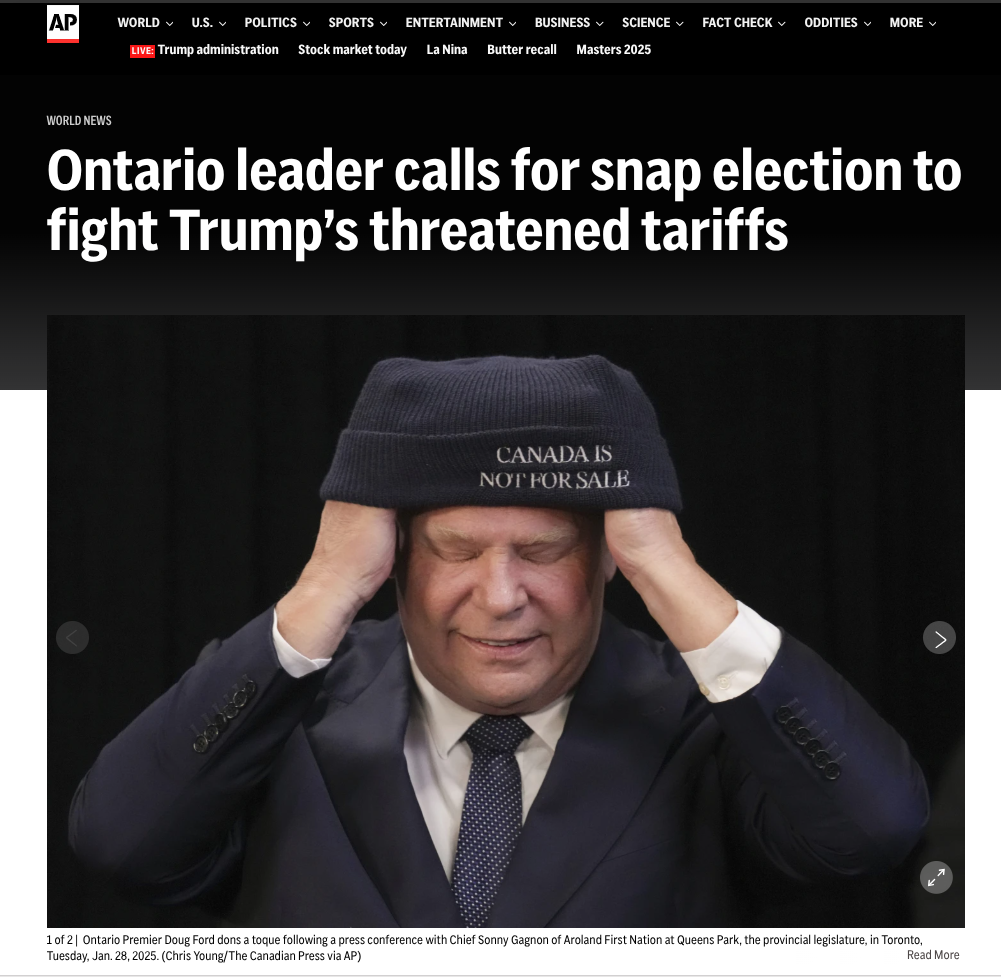
As part of the Captain Canada theatrics, Ford and his team have been receiving great mileage (via credulous media coverage) from announcing counter-measures against US economic threats that are little more than symbolic, if that. Photos and B-roll of empty shelves at the LCBO got heavy media play in Canada, but, in reality, American booze is still available at Ontario bars and restaurants (and casinos). Indeed, US beer, wine and ready-to-drink booze can be purchased in Ontario at more places than ever before, thanks to the Ford government - at grocery stores, big box stores and convenience stores.
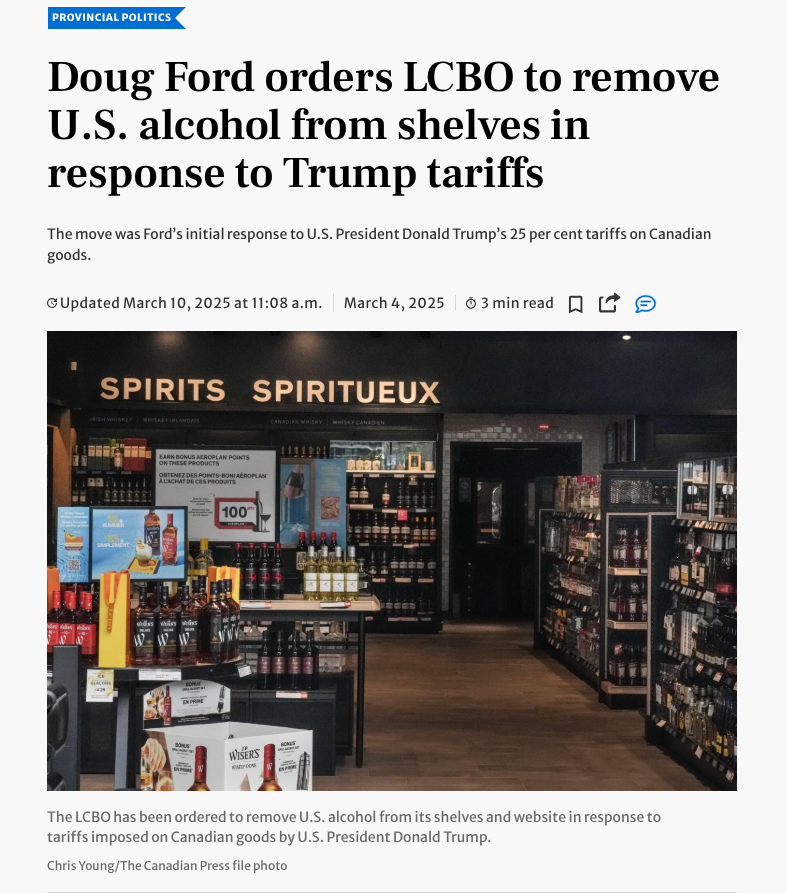
As we reported last year, Ford intends to end the LCBO, so it has been a useful prop to demonstrate his strength and forcefulness against Trump and the US while really harming nothing but the LCBO.
You may recall, Stephen Harper joined the board of CircleK just before Ontario paid millions in penalties to make booze available in convenience stores a year earlier than planned, so Ford wasn’t about to hurt convenience store sales. There is also a Weston (Galen’s cousin, Claudia Hepburn) on the board of the LCBO, so decisions about the LCBO are meant to benefit Loblaws. Loblaws has, for years now, expressed interest in replacing the LCBO as the booze distribution entity in Ontario. It goes without saying, Ford won’t harm sales at Loblaws.
There was also much media ballyhoo about Ford’s “energy charges”, and Trump’s team played along, as did US media. Ford threatened to tack a 25% “electricity surcharge” on Ontario electricity sold to a handful of US states. What went unsaid in all breathless, flag-waving coverage is that Ontario does not have contracts to supply electricity to any US states. Ontario often generates more electricity from nuclear and hydro than it needs, so we sometimes pay other states to take it. The media coverage was meant to leave an impression that Ontario is a critical supplier of electricity to these US states, which is not the case.
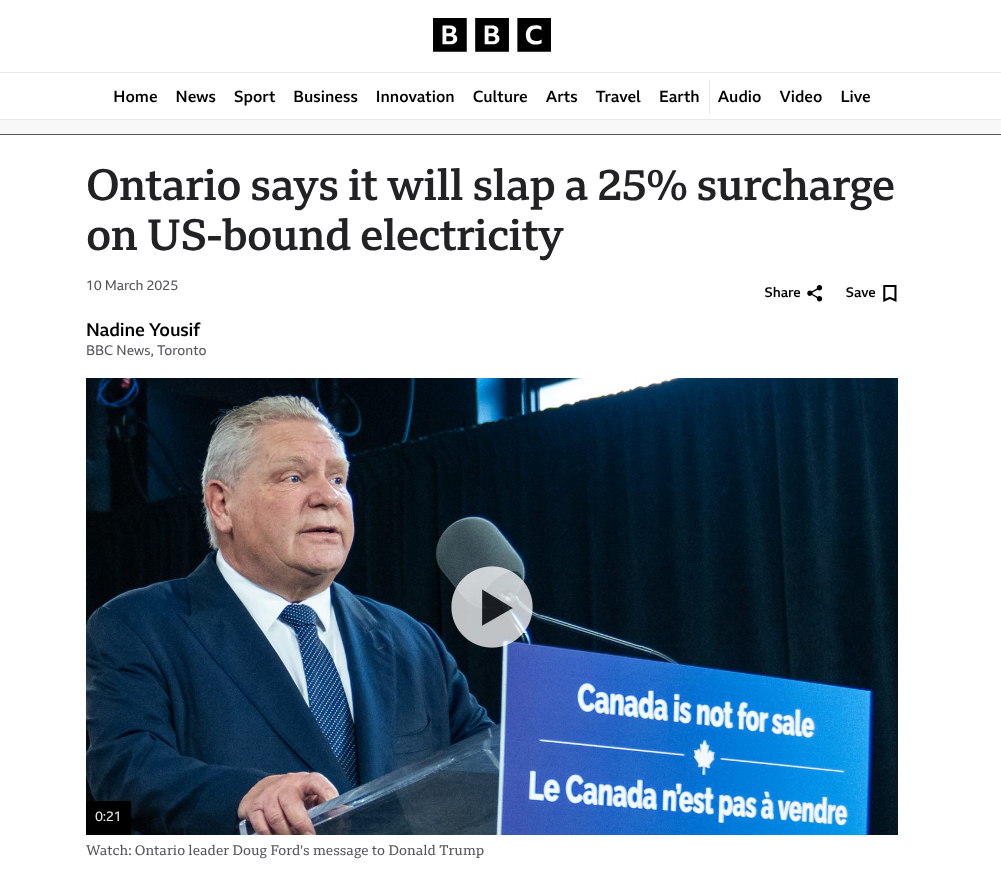
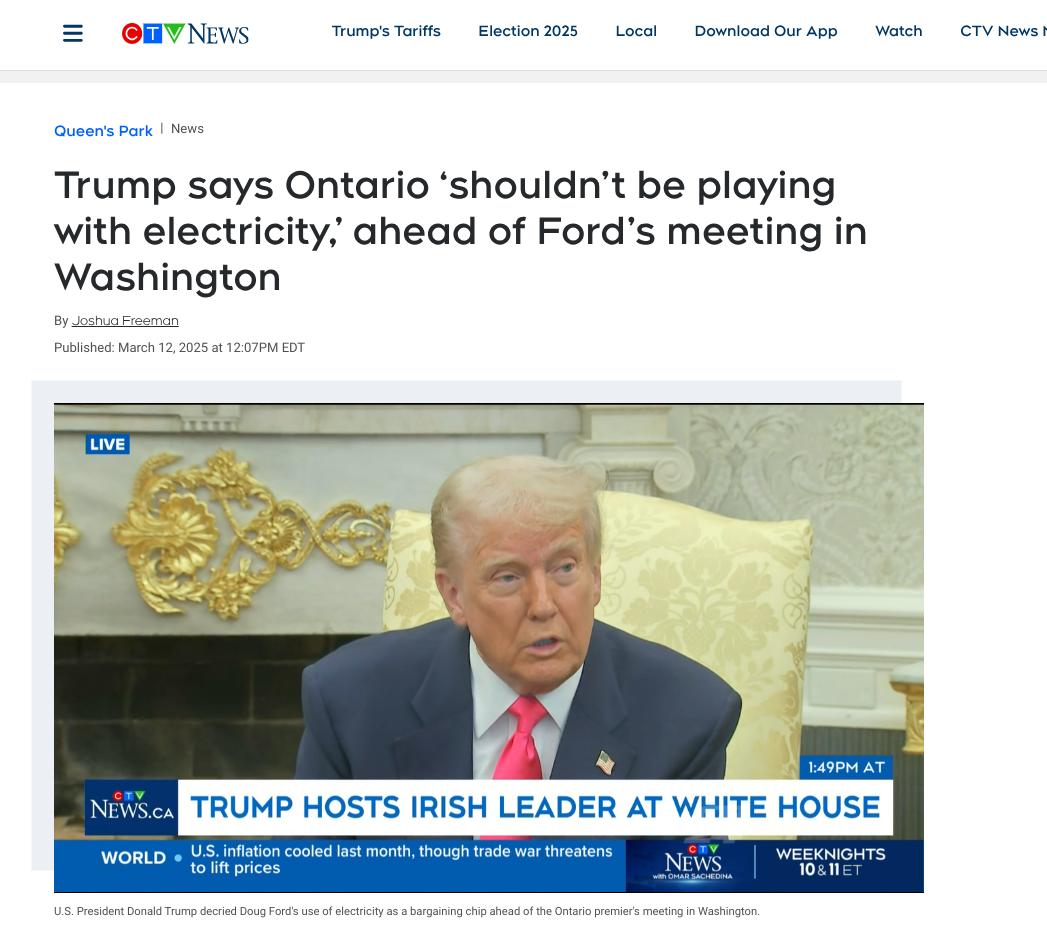
With help from their media partners in Canada and the US, Team Ford and Team Trump are both scoring points with their base for being “tough on” each other. In Canada, this was an opportunity for Ford to position himself as a savior for the rest of Canada, and in the US. Ford’s team has spent hundreds of millions on advertising the Ontario “success story” to the rest of Canada, and in the US as well. Like a pro wrestling story arc, this pre-planned storyline was meant to move the plot forward.
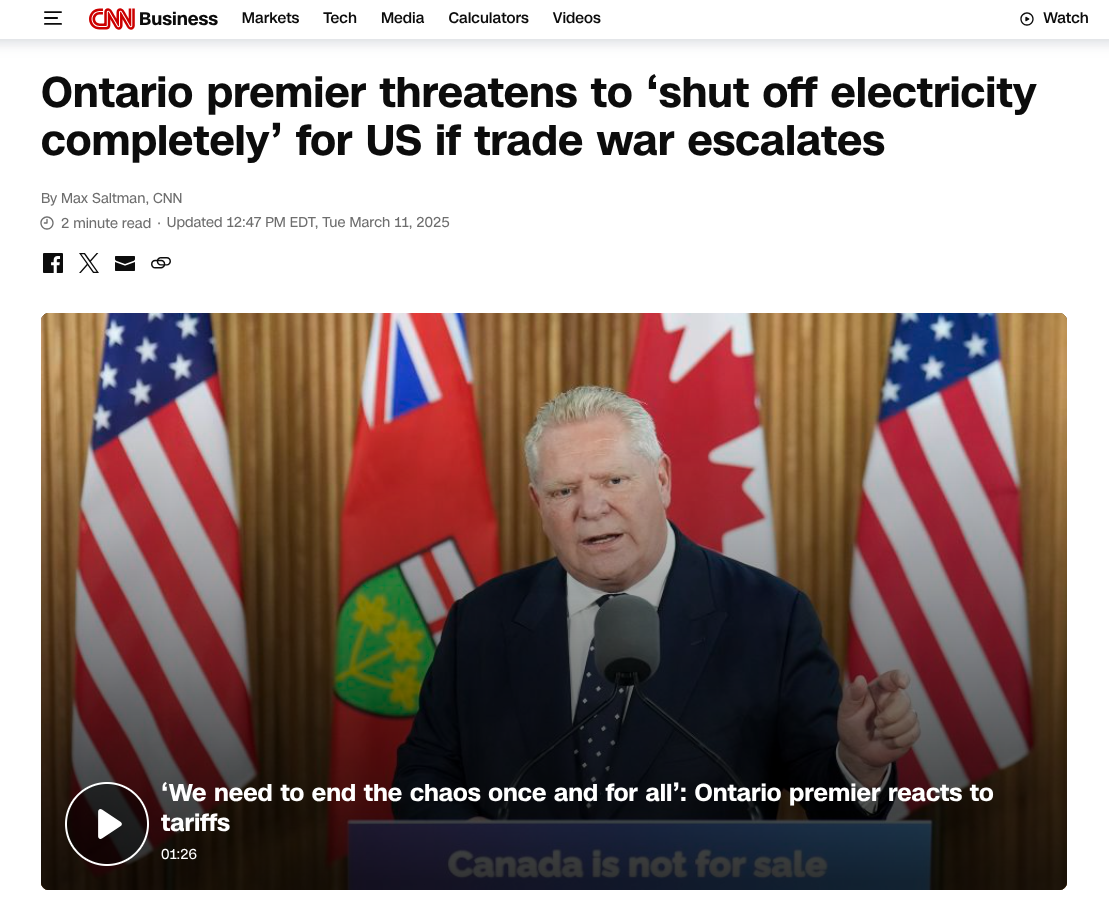
It should not be forgotten that the Republican Party and the Ontario PC Party (as well as the federal Conservative Party) are teammates via their membership in IDU. As we have written time and time again, IDU members cooperate, collaborate and share resources to help each other gain and keep power. Trump himself gave a low-key endorsement of Ford amidst the symbolic sabre rattling, calling him a “strong man.” This was a dog-whistle to Trump’s fans in Canada, and meant to demonstrate for the rest of Canada that Doug has Trump’s respect.
Doug Ford spent much of the Ontario provincial election campaign campaigning in Washington DC and on US cable news networks. Not at all coincidentally, Ford led a joint mission of Canada’s premiers to Washington on February 12, meeting with the new administration, congress and business leaders. Based on news coverage of that event, people who were unfamiliar with Canada would certainly get the impression Doug Ford is leading Canada’s response to Trump.
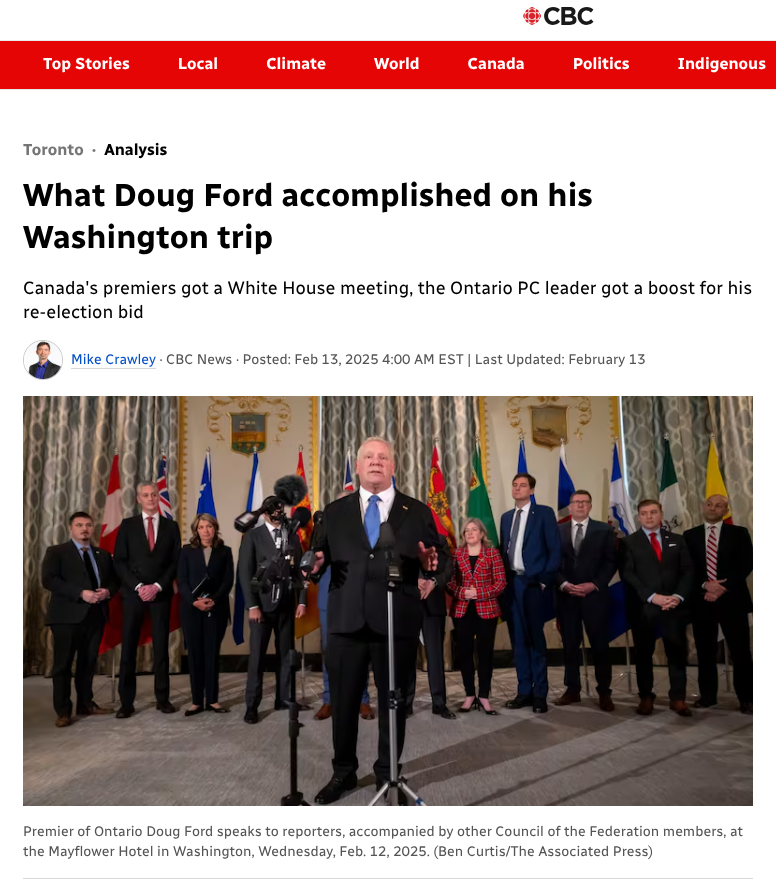
From this vantage point, it’s interesting to look back at what Ford was doing and saying in the period before Trump’s inauguration. Early in January, before Trump was inaugurated, Ford and his team were talking up their “Fortress Am-Can” proposal, including in an op-ed by Doug Ford published in the Wall Street Journal.
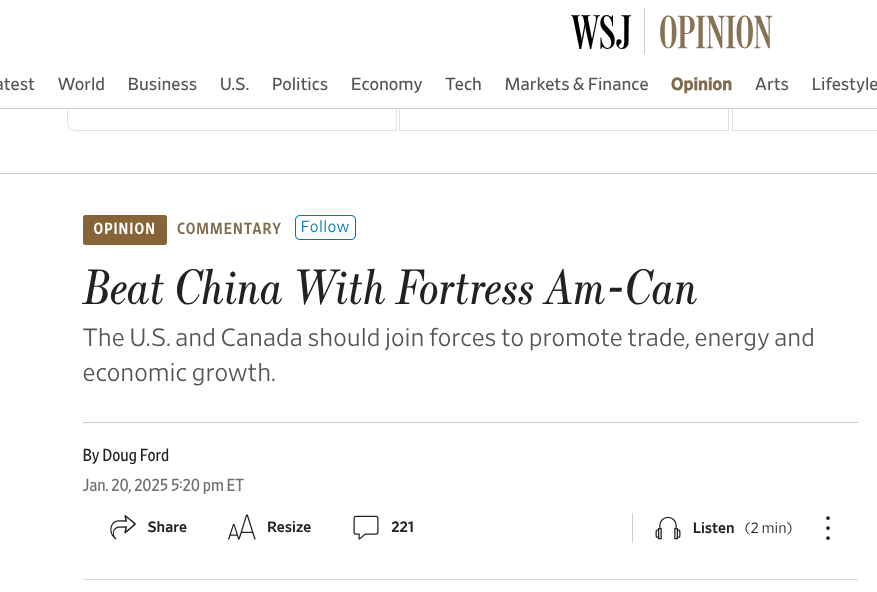
According to the Ford government, Fortress Am-Can “... envisions a new American and Canadian century… a renewed strategic alliance between the U.S. and Canada that’s a beacon of stability, security and long-term economic growth.”
In a preamble signed by Ford himself, Ford rehashes many Trump-friendly statements, including the trope that China is “ripping off American workers by hijacking global supply chains” and denigrating Mexico as “... a backdoor for cheap Chinese parts and products, undercutting and ripping off American and Canadian workers.”
Ford’s introduction goes so far as to speak for America, offering Canada as a helpmate to Trump’s American ambitions.

The Ford government’s proposals in Fortress Am-Can are mostly under federal jurisdiction. It envisions a comprehensive integration of Canada into American economic interests, particularly as it relates to critical minerals, oil and gas and nuclear power. It positions this economic integration as key to protecting democracy and fighting tyranny.
Using language which could have come directly from a Trump press briefing, Ford lays out an ultimatum for all countries - if you don’t stand with Washington, you stand with Beijing.
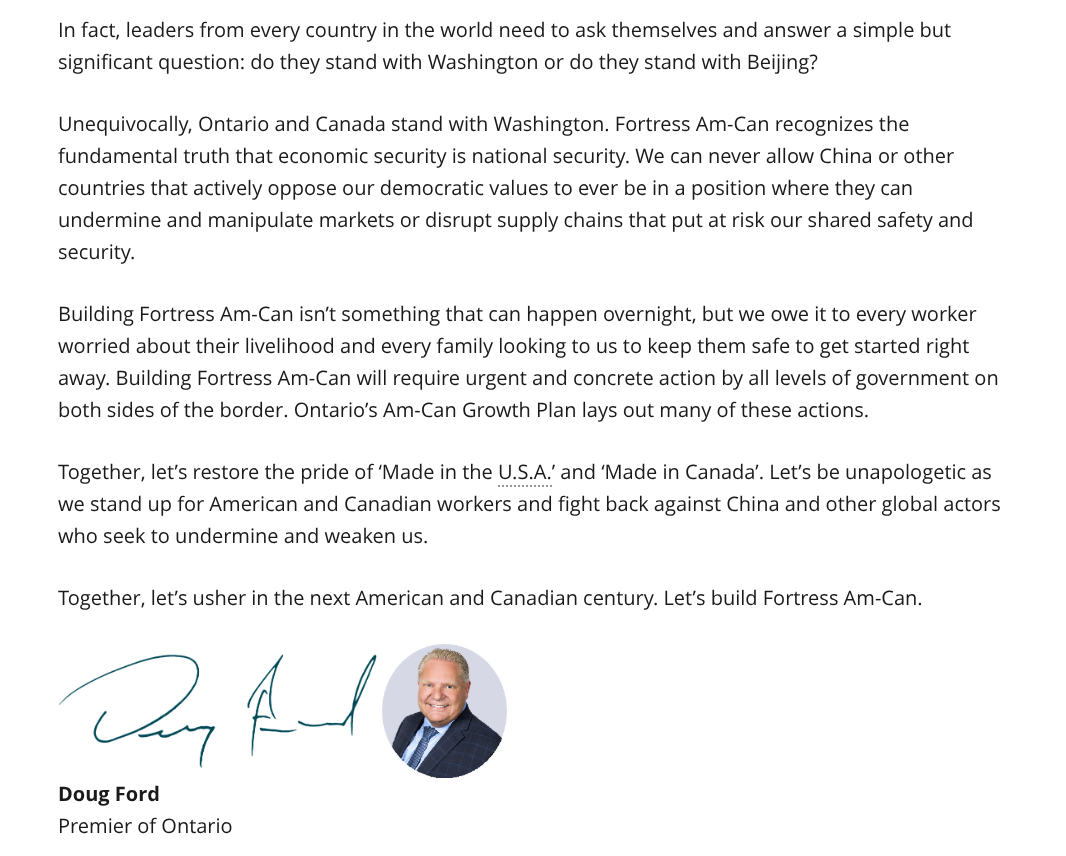
Fortress Am-Can includes over fifty individual proposals, grouped under categories designed to be music to Trump’s ears, as well as Elon Musk’s. Just a few of the more significant proposals are included below. Italics are mine.
- Ensure every member country to free trade agreements has policies against Chinese investment in critical minerals, and agrees to match U.S. policies designed to protect from China, including banning connected cars that use certain Chinese technology.
- Work with US lawmakers to rebuild and enhance America’s strategic oil and gas reserves.
- Prohibit China or state-owned enterprises to acquire, influence or subvert American or Canadian resources, including artificial intelligence and related technologies.
- Build relationships with U.S. partners to support agri-food supply chains and jobs in both countries.
- Establish cross-border partnerships between post-secondary, industry and union training centres to promote skills building roads and highways, manufacturing semiconductors and vehicles, and building energy production and transmission infrastructure.
- Harmonize, recognize and support professional certifications across Am-Can borders for engineers, doctors and other professional services.
- Build out American and Canadian critical mineral supply chains, expand processing capacity, and prioritize Canadian uranium to fuel nuclear energy capacity.
- Designate the Ring of Fire region as a region of strategic importance to the national security of Canada and the U.S, with a special approvals process to get minerals out of the ground fast.
- Work with the U.S. Department of Defense to prioritize shared national security objectives.
- Streamlining the approval of new small modular and large nuclear reactors.
- Meet and exceed Canada’s two percent NATO target for defence spending, and invest in NORAD operations and NORAD base restoration. The world can no longer free ride on the global security bought and paid for by U.S. taxpayers.
- Invest in Ontario’s innovation in artificial intelligence to support the future of autonomous combat aerial and underwater vehicles for military and border security and detection purposes.
- Increased permanent funding for more boots at the border and enhanced tools for law enforcement, and expanded cross-border coordination and operations between American and Canadian security and policing agencies.
- Enhanced data and intelligence sharing between federal, provincial, territorial and local police forces.
- Enhanced biometrics capabilities at Canada’s points of entry, including better tracking of entries and exits across Canada’s borders.
- Joint training, operations and scenario planning between American and Canadian armed forces, particularly in the Arctic.
- Guard critical interconnected data infrastructure such as high-value data centres by developing joint cyber risk mitigation practices.
Phrased to appeal to US Republicans (with its emphasis on the military, technology, surveillance, energy, and villainizing China) Ford’s Am-Can proposals envision a future of deeper integration between Canada and the US when it comes to our respective armed forces, energy grids, food systems, policing, and intelligence operations.
When it comes to critical minerals, Ford’s focus is getting them out of the ground and to US industry as quickly as possible, hopefully bounding over - with American support and pressure - any pesky regulatory requirements or interference from Indigenous communities.
One of the obstacles to developing Ring of Fire is the Matawa First Nations tribal council, which has pushed back on Ford’s announcement, reminding the Ontario government that it holds treaty and Aboriginal rights to the area in and around the Far North mineral belt. Chiefs characterized Ford’s Fortress announcement as “absent of any participation, input or engagement with the impacted communities.”
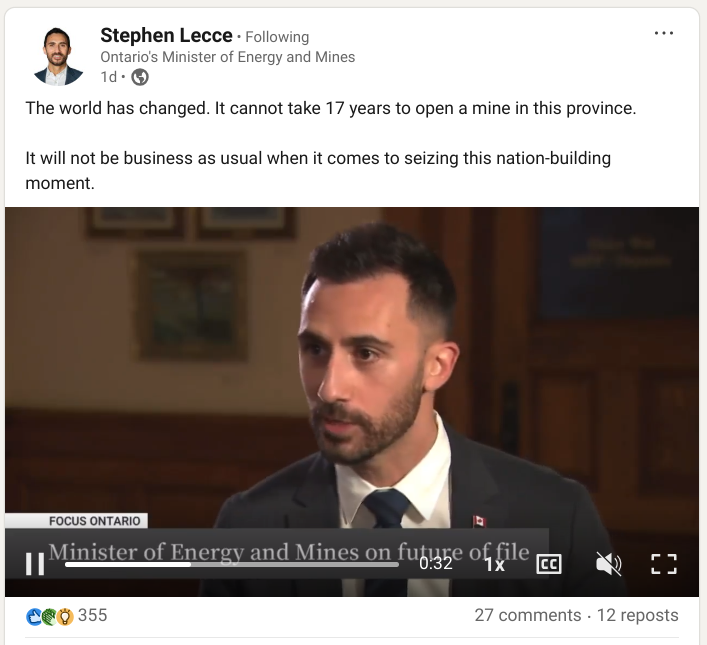
The Ring of Fire, in Northern Ontario, is rich with chromite, nickel, cobalt, platinum, copper and other minerals critical to industry and technology. Though mining firms stand to profit directly (Australia’s Wyloo Metals holds major claims in the region), infrastructure and construction firms will be awarded massive contracts to build roads, railways, power lines and processing facilities. Companies in engineering, construction and logistics will benefit.
Global technology companies and electric vehicle companies would also benefit from a stable supply of minerals for batteries and electronics. Companies like Elon Musk’s Tesla, GM, Ford and battery makers are likely investors and beneficiaries.
Canadian energy companies have much to gain from greater integration between Canada and the US. In terms of oil and gas pipelines and infrastructure, Enbridge (which operates the Line 5 pipeline, under US legal scrutiny) would benefit, as would the Pembina Pipeline.
TC Energy, formerly TransCanada Corporation, which operates the Keystone pipeline system, has been lobbying for expansion of terminals and transmission lines in the US for more liquified natural gas. The Investigative Journalism Foundation recently published an in-depth investigation on dozens of connections between TC Energy and the Trump administration, including family members, former colleagues and lobbyists.

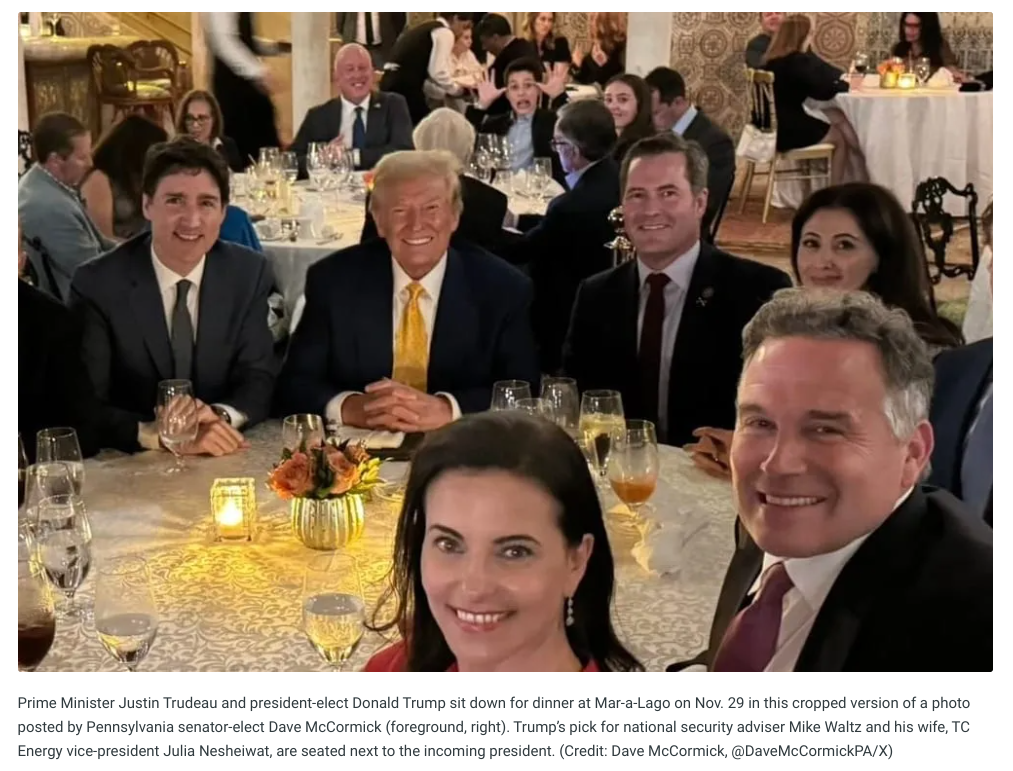
The article also outlined how TC Energy would benefit from being a “continental” firm rather than a Canadian one.
TC Energy has sought in recent years to remake itself as a continental firm, dropping Canada from its name and moving into larger U.S. headquarters at the former Bank of America building in Houston. Texas is not only important for the U.S. and global oil economies; it also shares a border with Mexico which, through agreements signed by previous Mexican governments, has become a customer for American gas production as its shale revolution makes it a fracking superpower.
As for Ontario, where our electricity system is a mix of public and private ownership, private companies (like TransAlta, Brookfield and Capital Power) own and operate about 40%-50% of Ontario’s electricity generation capacity, and would welcome bigger markets. Ontario has over 60 LDCs (or local distribution companies), some of which are municipally owned and some (including EPCOR and Hydro One’s distribution arm) are private.
Outside of energy, a number of other sectors have angled for more integration with the US market, including the automotive and EV supply chain (benefiting Magna International, Linamar and Martinrea), mining (benefiting Teck Resources and Sherritt International), and financial services and technology (benefiting RBC, TD, Scotiabank, Shopify and OpenText).
Corruptario is a reader-supported publication. To receive new posts and support our work, consider becoming a free or paid subscriber. If you find this work valuable, you can leave us a tip!
